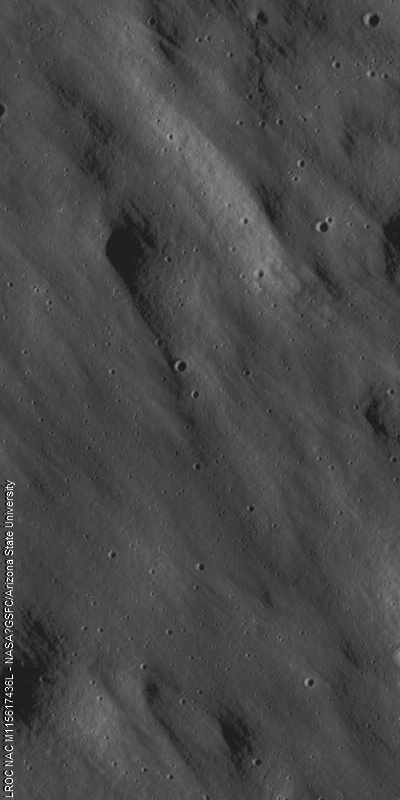An erosional trough (400 meters long x 100 to 200 meters wide) represents a significant chunk of material slipped down the steep upper inside east wall of the notably bright farside crater Moore F. Morphologically it resembles a martian sapping feature, suggested as the result of erosion by water flowing and undermining the subsurface. LROC Narrow Angle Camera observation M128075293R, LRO orbit 4008, May 9, 2010, Field of view is 500 meters, with the Sun from the southwest at lower right [NASA/GSFC/Arizona State University].
Jeff Plescia
LROC News System
 A number of erosional troughs are observed on the inner wall of Moore F on the lunar far side (37.21°N, 185.48°E). The crater is 23.7 km in diameter and is relatively fresh, as evidenced by bright ejecta and its pristine morphology. Numerous troughs are observed extending down the inner crater wall. The feature shown here is the freshest with a smooth floor composed of bright material.
A number of erosional troughs are observed on the inner wall of Moore F on the lunar far side (37.21°N, 185.48°E). The crater is 23.7 km in diameter and is relatively fresh, as evidenced by bright ejecta and its pristine morphology. Numerous troughs are observed extending down the inner crater wall. The feature shown here is the freshest with a smooth floor composed of bright material.The trough is about 810 meters long and around 140 meters wide near its head, narrowing slightly to about 105 m in the middle before widening to some 200 meters.
Several other older troughs occur along the crater wall to the north and south of this feature. They all appear to begin at about the same level of the crater wall, an area marked by what appears to be discontinuous outcrops of bedrock. The older features are darker, with an albedo similar to the surrounding terrain, as opposed to this feature, which has a considerably higher albedo.
These features resemble so-called sapping features observed on Mars. The martian features are suggested to be formed by the release of ground-water along a cliff face causing headward erosion of the trough. In these lunar examples, it is highly unlikely that ground water occurs. Presumably the features are the result of dry debris flows of fine-grained, unstable material. Once mobilized, the dry granular flow broadened into a fan-shaped deposit. Here the material extends more than a kilometer downslope from the mouth of the trough.
Explore the full NAC image.
Check out a related post!
Explore the full NAC image.
Check out a related post!







































